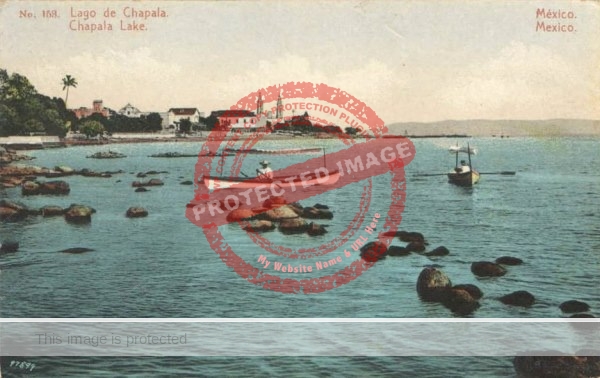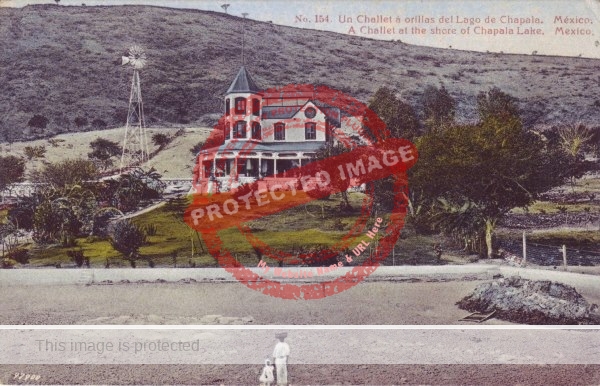At least two postcards of Lake Chapala from the late 1920s bear the imprint on their reverse side of “F. Martín. Mexico, D.F.” and a stylized “FM” circular logo. According to researcher Arturo Guevara Escobar, the “F. Martín” name was registered as a trade name and used for about 50 years for several distinct series of postcards, which makes it likely that the estimated 1000+ postcards produced by the firm represented the work of more than one individual.
The main “F. Martín” series has bilingual captions in red numbered from 1 to at least 628. This series includes the two cards illustrated here. It is unknown whether these photographs, which date from the 1920s, were taken by Martín himself or were the bought-in work of other photographers.

F. Martin. c 1928 (?). “Lago de Chapala.”
The card above (#158) shows a view of Chapala from the west towards the town and jetty of Chapala. The twin towers of the Church of San Francisco are especially prominent.
The card below (#154) is one the very few postcards showing Villa Virginia, one of the numerous elegant villas built along the lakeshore in the period 1890-1930. This particular villa, west of the jetty, and still standing, was built after 1905 by the Hunton family. The matriarch of the family was the basis for the title character of Arthur Davison Ficke’s 1939 novel “Mrs Morton of Mexico.” (See chapter 31 of If Walls Could Talk: Chapala’s Historic Buildings and Their Former Occupants.)

F. Martin. c 1928 (?). “Un challet a orillas del Lago de Chapala”
The images on both postcards have five-digit numbers—97899 and 97900 respectively—in tiny white font in the lower left corner. These numbers appear to be identical in style to the five-digit numbers found on cards published (at approximately the same time) by “S. Altamirano” of Guadalajara, so it is likely that the two publishers had a commercial relationship.
The mystery of F. Martín
Arturo Guevara Escobar decided that postcards marked “F. M.” or “F. Martín” were almost certainly the work of Félix Martín Espinoza, who lived in Mexico City, and was a member of the committee responsible for overseeing Mexican participation in the World’s Columbian Exposition (Chicago World’s Fair) in 1893. The address of this individual in the first decade of the 20th century was 1er Callejón de López #416.
Display adverts in the Mexico City press from 1901 to 1913 tie that address (and a series of others) to the “Yucatán Medicine Co.” a company selling patent medicines, including a vegetable oil for hair color restoration made by the doctor. At least one of the hair restorer ads gives the doctor’s full name as “Félix Martín Espinoza L.” This would mean that “Martín” was not the doctor’s paternal surname (as the name “F. Martín” would suggest) but was actually his second name, and that his paternal surname was Espinoza. It would have been very unusual at the start of the twentieth century to use two forenames as an advertising/company name, so I believe we need to find a stronger candidate for the “F. Martín” who published postcards.
A much more likely candidate, in my opinion, though no further biographical details are known, is the “Félix Martín” who lived at “5a Capuchinas 89, Mexico City,” and placed regular advertisements in The Mexican Herald from October 1913 to April 1914 claiming to be “The best place in the city to buy postal cards at wholesale prices.” A subsequent F. Martín campaign, in El Pueblo from 1915 to 1919, offered “postcards of every type and style.” The Capuchinas address was a commercial premises which had previously belonged to Bordenave & Coryn, “General Agents for Scotch Whisky Perfection, American Whiskey, Ceylon Tea, etc.”
My 2022 book Lake Chapala: A Postcard History uses reproductions of more than 150 vintage postcards to tell the incredible story of how Lake Chapala became an international tourist and retirement center.
Note: This post was first published 30 July 2019.
Source
- El Imparcial: diario ilustrado de la mañana,12 April 1913, 6.
- El Pueblo: 12 Nov 1915, 5; 19 Jan 1919, 6.
- El Siglo Diez y Nueve, 30 April 1884, 4.
- Arturo Guevara Escobar. 2011. Letra: M. “Fotógrafos y prodcutores de postales.” Originally published 19 November 2011.
- The Mexican Herald: 14 October 1913, 6; 7 April 1914, 6.
- Semanario Literario Ilustrado, 1 July 1901.
Comments, corrections and additional material are welcome, whether via the comments feature or email.
Tony Burton’s books include “Lake Chapala: A Postcard History” (2022), “Foreign Footprints in Ajijic” (2022), “If Walls Could Talk: Chapala’s historic buildings and their former occupants” (2020), (available in translation as “Si Las Paredes Hablaran”), “Mexican Kaleidoscope” (2016), and “Lake Chapala Through the Ages” (2008).
wow: great photos and detective work–thanks
Thanks Bill! Always good to know there are loyal readers out there! Keep well, TB.